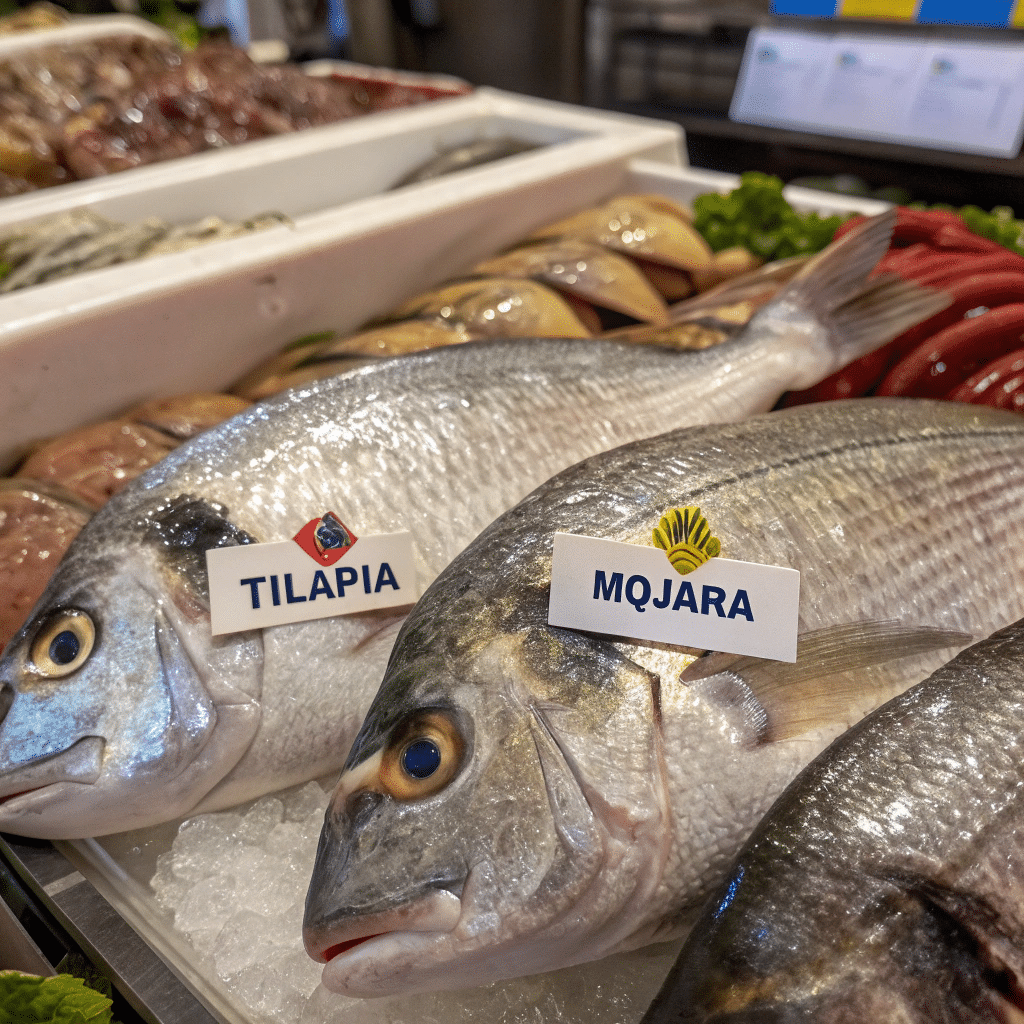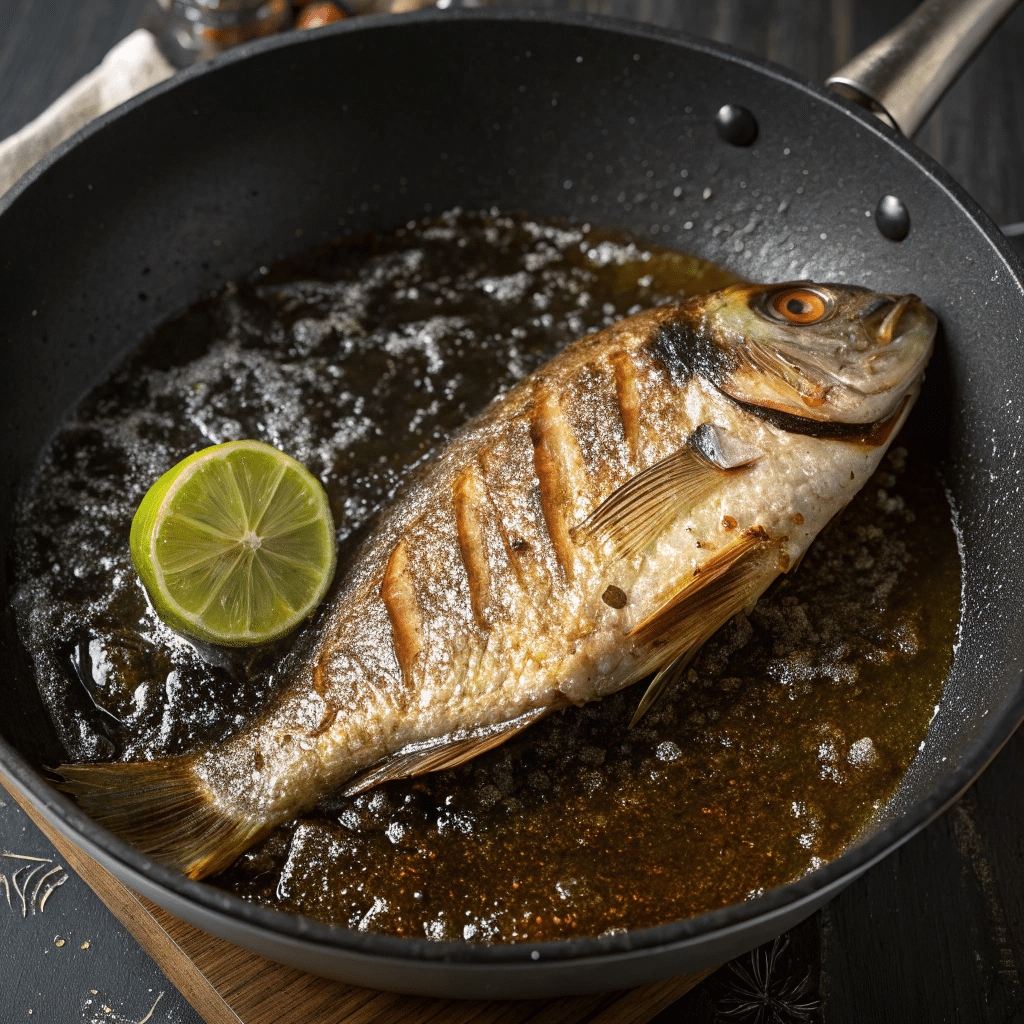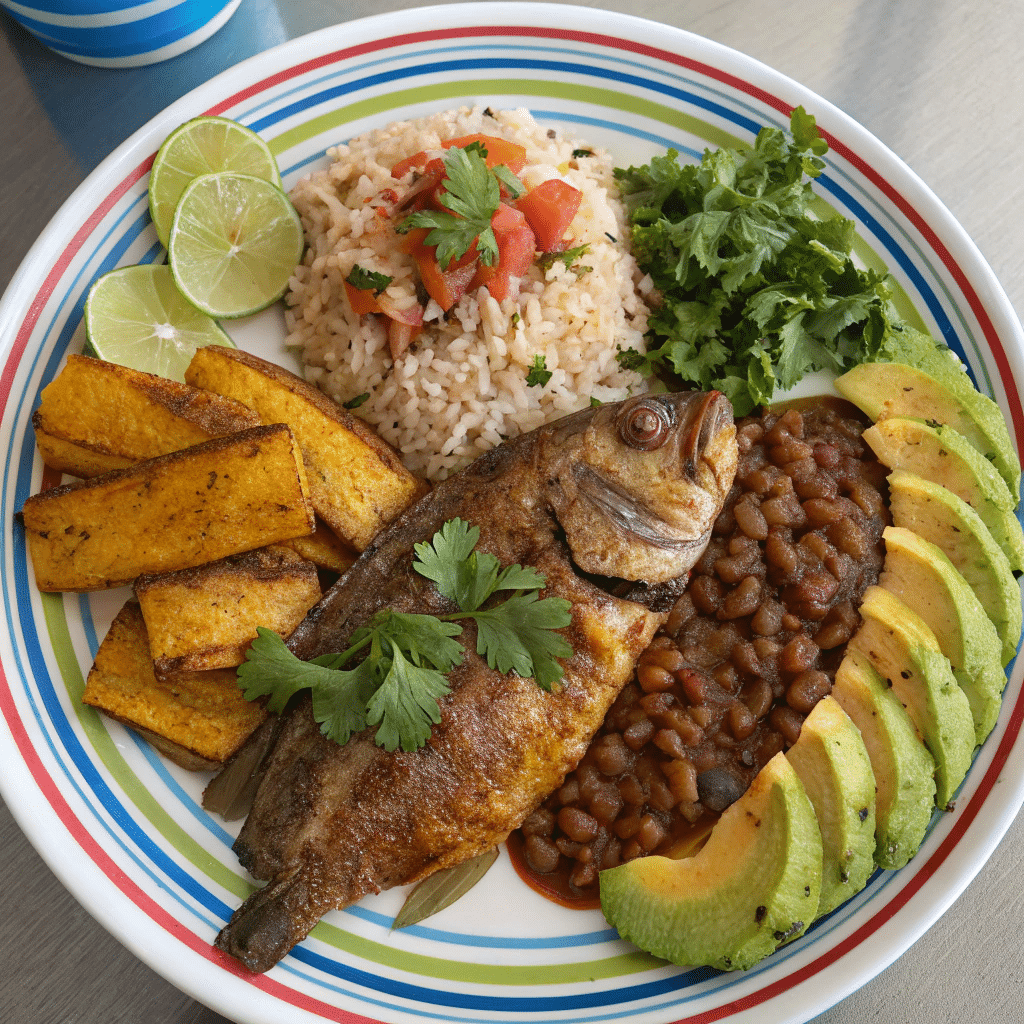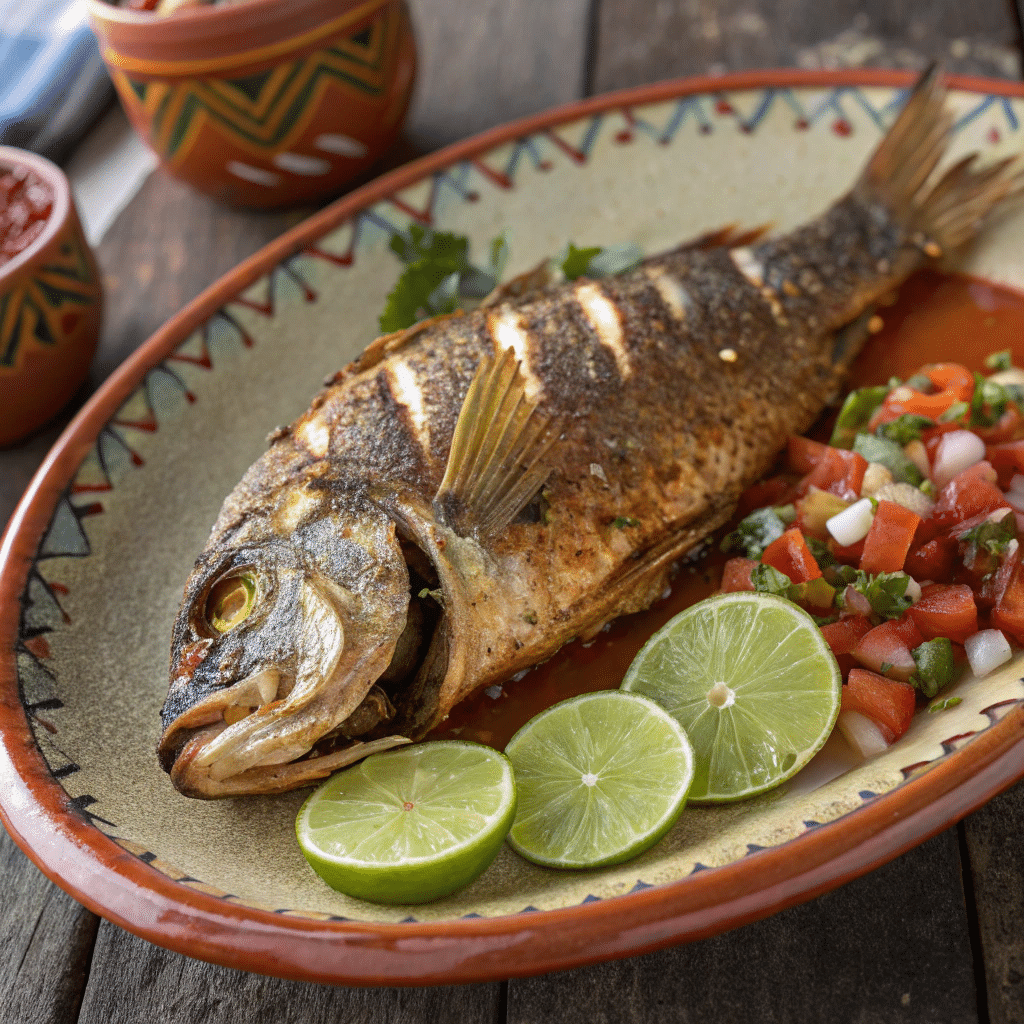Craving something crispy, flavorful, and rich in Latin tradition? You’re in for a treat. This article dives deep into mojarra frita, a wildly popular dish across Latin America and especially in Mexican coastal kitchens. Whether you’ve seen it sizzling on the stove or tasted it served with rice and lime at a street market, this guide will show you everything you need to know—from the type of fish used to how to cook it like a pro.
We’ll cover how mojarra differs from tilapia, go step-by-step through the perfect recipe, and even share some incredible side dishes and sauce pairings. Plus, you’ll find helpful tips to avoid cooking mistakes and learn about its nutritional profile.
Check out this quick guide to Cottage Cheese Chips Recipe – a crunchy snack for a healthier alternative when you’re not craving seafood.
What Is Mojarra Frita?
The Origin and Cultural Significance of Mojarra Frita
Mojarra frita is more than just a crispy fish dish—it’s a culinary tradition rooted in coastal and inland regions across Latin America. In Mexico, especially near the Pacific and Gulf coasts, families gather around this savory fish meal during weekends and holidays. It’s commonly served whole: head, tail, and all, seasoned generously and fried until golden.
The word mojarra refers to various species of fish, usually from freshwater or brackish waters. It’s often associated with tilapia in North America, but globally, mojarra can refer to species like Eugerres plumieri or Gerreidae.
This dish is a staple in casual beachside restaurants, roadside food stands, and family kitchens. Its visual appeal—crispy skin, flaky meat, served whole—makes it a centerpiece meal in Latin cuisine.
Don’t miss our popular Brazilian Mounjaro Recipe – A fat-burning elixir if you’re looking to balance indulgence with health.
What Makes Mojarra Frita a Staple in Latin Cuisine?
The beauty of mojarra frita lies in its simplicity and bold flavor. You season the fish with lime, garlic, salt, and spices, then deep-fry it whole until it’s crispy outside and juicy inside. The result is a dish that’s hearty, shareable, and deeply satisfying.
Mojarra frita is often served with:
- Mexican rice
- Refried beans
- Fresh salad or shredded cabbage
- Lime wedges and spicy salsa
It’s comfort food. But more than that, it’s cultural food—something passed down from grandparents to grandchildren, a way to bond over cooking, and a must-have for celebrations.
Discover great ideas like Transfusion Mocktail – A refreshing alcohol-free drink to pair with your fried fish feast.
Understanding the Fish – What Kind of Fish is Mojarra?

Is Mojarra a Specific Type of Fish or a Group?
The term mojarra often confuses people outside Latin America. It’s not the name of one specific fish—it’s a general term used across Spanish-speaking countries to describe various small to medium-sized fish, especially those suitable for frying.
In Mexico and much of Central America, mojarra refers to:
- Tilapia (most commonly used in U.S. versions of the dish)
- Native fish from the Gerreidae family
- Local freshwater species like Mojarra blanca and Mojarra negra
What ties all these fish together isn’t their species—it’s their body shape and texture. Mojarra fish are generally:
- Oval or disc-shaped
- Bony, with firm flesh
- Perfect for absorbing seasonings and holding their form during frying
If you’re shopping at a Latin grocery store or fish market and ask for mojarra, you’ll likely be handed a whole tilapia, gutted but with skin, head, and fins intact—perfect for mojarra frita.
Looking for inspiration? Try this Salt Water Taffy Gluten-Free Guide if you’re managing dietary preferences alongside cooking plans.
Mojarra vs Tilapia – What’s the Difference?
It’s easy to assume mojarra and tilapia are the same, especially in U.S. restaurants where the two terms are often used interchangeably. But technically, there’s a difference:
| Feature | Mojarra | Tilapia |
|---|---|---|
| Definition | Generic term for fryable small fish | Specific species, mainly farm-raised |
| Species | Can be Gerreidae or Cichlidae | Cichlid family, includes Nile tilapia |
| Usage in cuisine | Regional, broad fish category | Most commonly used as “mojarra” in U.S. |
| Flavor | Mild, slightly earthy | Very mild, flaky texture |
| Price & Access | Varies by region | Widely available and affordable |
In essence, mojarra is a category while tilapia is a species. But in the kitchen, when you hear mojarra frita, you can almost always assume it means fried whole tilapia, unless otherwise specified.
So if you’re planning to make mojarra frita at home, buying whole tilapia will get you the most authentic experience.
Ingredients and Preparation Essentials
Fresh vs Frozen Mojarra – Which Is Best for Frying?
When it comes to preparing authentic mojarra frita, the freshness of the fish can make or break the flavor. Both fresh and frozen mojarra (usually tilapia) are commonly used, but they have key differences.
Fresh Mojarra
- Has a naturally firmer texture and brighter flavor
- Ideal for traditional recipes and deep frying
- Short shelf life—must be cooked soon after buying
Frozen Mojarra
- More convenient and easier to find in U.S. markets
- Affordable and available year-round
- Slightly less firm after thawing, so it’s important to pat it dry thoroughly to avoid excess oil splatter during frying
Pro tip: If using frozen fish, thaw it overnight in the fridge and let it rest at room temperature for 30 minutes before cooking. This helps prevent rubbery texture and ensures even frying.
Check out our Lemon Balm Tea Recipe – A natural fat burner if you’re looking to detox after a delicious fried meal.
Must-Have Ingredients for Authentic Mojarra Frita
Creating a delicious mojarra frita starts with the right ingredients. This isn’t a dish that needs a long list of fancy items—just bold, fresh, and flavorful essentials.
Basic Ingredients List:
- 1 whole mojarra (tilapia), cleaned and scaled
- Fresh lime juice (for flavor and acidity)
- Minced garlic (or garlic paste)
- Salt and black pepper to taste
- Mexican seasoning or paprika
- All-purpose flour or cornmeal (optional, for extra crispiness)
- Vegetable oil (for deep frying)
- Fresh herbs (like cilantro or oregano – optional garnish)
Optional Add-ins:
- Chili powder or cayenne for heat
- Sliced onions and peppers for stuffing the cavity
- Bay leaves or epazote for a more herbal aroma
Want to make it extra traditional? Marinate the fish for 30–60 minutes with lime, garlic, and spices before frying. This helps the flavors infuse deeper into the flesh.
Don’t miss our Pink Salt Weight Loss Recipe – 5 Proven Benefits if you’re curious about natural cooking ingredients that can do more than just taste good.
Summary Table: Fresh vs Frozen for Mojarra Frita
| Feature | Fresh Mojarra | Frozen Mojarra |
|---|---|---|
| Flavor | Stronger and more natural | Slightly milder |
| Texture | Firmer and flakier | Softer if not thawed correctly |
| Availability | Seasonal or regional | Year-round availability |
| Prep Time | Shorter, ready to use | Requires thawing |
| Cost | Slightly higher | More budget-friendly |
Step-by-Step Recipe for Perfectly Crispy Mojarra Frita

Prepping the Fish: Cleaning, Scoring, and Seasoning
If you want your mojarra frita to come out crispy on the outside and juicy on the inside, the prep work matters just as much as the fry. Here’s a foolproof breakdown of how to get your fish ready:
Step 1: Clean the Fish Thoroughly
Whether fresh or frozen, make sure your mojarra (usually tilapia) is fully scaled, gutted, and rinsed. Use a sharp knife to remove any remaining scales under running water.
Step 2: Pat Dry and Score the Skin
Use paper towels to pat the fish completely dry. This helps it fry evenly and prevents oil splatter. Then, score both sides of the fish with diagonal slits. These cuts:
- Allow seasoning to penetrate the meat
- Help the fish cook faster and more evenly
Step 3: Season Generously
Rub both sides and inside the cavity with:
- Fresh lime juice
- Salt and black pepper
- Minced garlic or garlic powder
- Paprika or chili powder (for heat)
Let it sit for at least 20–30 minutes. For deeper flavor, marinate in the fridge for up to 2 hours.
Looking for inspiration? Try our Brazilian Mounjaro Recipe with Apple Cider Vinegar for a powerful, natural meal companion.
Frying Techniques: Temperature, Timing, and Tips
Here’s where the magic happens—getting that golden, crispy crust without drying out the inside.
The Best Way to Fry Mojarra:
- Use a deep, wide skillet or wok and heat enough vegetable oil to cover at least half the fish.
- Heat the oil to 350–375°F (177–190°C). Use a thermometer if possible. If the oil is too cold, the fish will be greasy. Too hot, and it’ll burn.
Frying Steps:
- Carefully lower the fish into the oil using tongs or a slotted spoon.
- Fry each side for 5 to 7 minutes, depending on size.
- Use a splatter guard if needed.
- Flip only once to prevent breaking the skin.
Once golden brown, transfer to a plate lined with paper towels to absorb excess oil.
Bonus Tip:
If you want extra crispiness, lightly coat the fish in flour or cornmeal before frying. This is optional but highly recommended.
Check out this light pairing idea with our Lemon Balm for Weight Loss Recipe—a tea that’s great after heavy meals like fried fish.
Quick-Fire Frying Chart
| Fish Size | Oil Temp (°F) | Fry Time Each Side | Total Fry Time |
|---|---|---|---|
| Small (1 lb) | 350°F | 4–5 minutes | 8–10 minutes |
| Medium (1.5 lb) | 360°F | 6 minutes | 12 minutes |
| Large (2+ lb) | 375°F | 7–8 minutes | 14–16 minutes |
Best Sides and Sauces to Serve with Mojarra Frita

Top 5 Traditional Sides that Pair Perfectly
A great mojarra frita is delicious on its own, but the right sides take it to the next level. In Mexican and Latin American kitchens, it’s all about combining flavor, texture, and freshness. These are the top 5 sides traditionally served with mojarra frita:
- Arroz Mexicano (Mexican Rice)
Fluffy rice seasoned with tomato, garlic, onion, and chicken broth. It balances the richness of fried fish with its savory-sweet profile. - Refried Beans
Creamy and hearty, refried pinto or black beans make a classic combo. They add protein and a smooth texture next to the crispy fish. - Tostones or Fried Plantains
Crunchy on the outside and sweet on the inside, tostones offer a tropical contrast. They’re especially popular in Central American versions of mojarra frita. - Shredded Cabbage Salad with Lime Vinaigrette
A fresh, zesty slaw that cuts through the oiliness and adds a tangy crunch. - Warm Corn Tortillas
Always served on the side to help scoop up fish, rice, and beans—or to make quick tacos on the spot.
You can serve all five, or mix and match based on what you’ve got in the pantry.
Discover great ideas like this refreshing Transfusion Mocktail Guide that pairs surprisingly well with bold fried dishes.
Homemade Sauces to Elevate the Flavor
Fried fish deserves bold dipping sauces and salsas that enhance its flavors without overpowering them. Here are the top go-to condiments for mojarra frita:
Salsa Verde
- Made with tomatillos, jalapeños, and cilantro
- Adds tang and heat
- Best served warm or at room temperature
Garlic-Lime Crema
- Blend sour cream, fresh lime juice, garlic, and salt
- Creamy, citrusy contrast to the crispy fish
- Great for drizzling or dipping
Mango Habanero Salsa
- Sweet and spicy fusion that complements fish beautifully
- Adds tropical flair to the dish
Spicy Mayo
- Mix mayo with hot sauce or Sriracha
- Simple, creamy, and just the right heat
These sauces can be served on the side or directly over the fish. Either way, they’ll elevate the meal from great to unforgettable.
Looking for inspiration? Try our Pink Salt Trick Recipe – Natural Morning Ritual to balance indulgent meals with wellness.
Recommended Pairing Table
| Side Dish | Why It Works with Mojarra Frita |
|---|---|
| Mexican Rice | Mild and savory; balances fried texture |
| Refried Beans | Creamy, rich, and protein-packed |
| Fried Plantains | Sweet counterpoint to salty fish |
| Lime Cabbage Salad | Zesty, crunchy, and refreshing |
| Garlic-Lime Crema | Tangy dip that enhances fried crispiness |
Mojarra Frita Nutritional Facts
Calories and Macronutrients Breakdown
So, how healthy is mojarra frita? While it’s undeniably delicious, it’s also a fried dish—which raises valid questions about its nutrition profile.
Let’s break it down.
On average, a single fried whole mojarra (around 1.5 lbs) contains:
| Nutrient | Amount (Per Serving – 1 Fish, Fried) |
|---|---|
| Calories | 350–500 kcal |
| Protein | 40–50 grams |
| Fat | 18–25 grams |
| Carbohydrates | 0–5 grams (mainly from flour, if used) |
| Sodium | 400–600 mg (varies by seasoning) |
| Cholesterol | 90–110 mg |
These numbers vary depending on:
- The size of the fish
- Frying oil used
- Whether flour or breading is added
- Marinade ingredients
Despite being fried, mojarra frita is rich in protein, omega-3s (if not over-fried), and essential minerals like potassium and phosphorus. Compared to heavily processed fast food, it’s still a more wholesome, whole-food option.
Don’t miss our Lemon Balm for Weight Loss Recipe if you want to balance your meals with natural herbal options.
Is Mojarra Frita a Healthy Meal Option?
Let’s be real—anything deep-fried isn’t going to win top marks for clean eating, but when compared to other comfort foods, mojarra frita has some surprising upsides.
Health Benefits:
- High in lean protein: Essential for muscle repair and energy
- Natural fish fats: Offers heart-healthy omega-3s
- Whole food ingredients: No processed additives if made from scratch
Things to Watch:
- Sodium levels can rise with heavy seasoning or salty sides
- Oil type matters: use clean, high-smoke-point oils like avocado or sunflower oil
- Portion control is key—pair with lighter sides like salad or grilled veggies
Check out our Salt Water Taffy Gluten-Free Guide for more smart choices around indulgent foods.
Nutrition at a Glance
| Pros | Cons |
|---|---|
| High in protein | Fried, so higher in fat |
| Full of flavor from spices | Can be high in sodium |
| Low carb (unless battered) | Calories can add up with oil |
| Contains minerals & omega-3s | Not ideal for low-fat diets |
Regional Variations and International Twists
Mojarra Frita Across Latin America – A Taste Tour
While mojarra frita is widely loved in Mexico, it’s also a staple dish in many other Latin American countries, each putting their unique spin on it. The base idea—fried whole fish—remains consistent, but the accompaniments, seasoning, and even the type of mojarra can vary based on location.
Mexico
- Usually uses tilapia or mojarra blanca
- Commonly served with rice, beans, lime, and salsa roja or verde
- Popular in coastal towns and street markets
El Salvador
- Often served with casamiento (rice and beans mixed together)
- May include a side of curtido (pickled cabbage slaw)
Guatemala
- Features spicier marinades, often with dried chili rubs
- Accompanied by boiled yuca or tortillas
Honduras
- Seasoned with cumin, lime, and garlic paste
- Often served with plantains and avocado slices
Colombia & Venezuela
- Known as “mojarra frita con patacones” (with fried green plantains)
- Accompanied by arepas or tropical fruit salsas
These regional versions show how mojarra frita isn’t just one dish—it’s a framework for comfort food shaped by climate, culture, and local flavors.
Want to connect with more traditional Latin flavor twists? Check out my cooking posts on Facebook: Follow My Recipe Page Here
Creative Twists: Grilled, Baked, or Air-Fried Mojarra
If you love the idea of mojarra frita but want a lighter or modernized approach, there are plenty of ways to keep the flavor without all the frying.
Grilled Mojarra
- Rub the fish with garlic, lime, olive oil, and herbs
- Wrap in banana leaves or foil
- Grill over medium-high heat for 6–8 minutes per side
- Result: Smoky, juicy fish with a crisp outer edge
Baked Mojarra
- Preheat oven to 400°F
- Place scored, seasoned mojarra in a baking dish
- Add lemon slices and veggies for extra moisture
- Bake for 20–25 minutes
- Bonus: No oil splatter, still flaky and flavorful
Air-Fried Mojarra
- Best for health-conscious eaters
- Spray lightly with oil, season, and air fry at 375°F for 12–15 minutes
- Flip halfway through for an evenly crisped texture
These alternatives keep the mojarra flavor alive while reducing calories and cleanup. They also open the door to weeknight-friendly versions of the dish.
Comparison Table: Classic vs Modern Twists
| Method | Texture | Health Level | Prep Time | Best For |
|---|---|---|---|---|
| Deep-Fried | Crispy, rich | Moderate | Fast | Traditional flavor seekers |
| Grilled | Smoky, slightly crispy | Healthier | Medium | BBQ lovers |
| Baked | Moist, tender | Very Healthy | Easy | Low-fat diets |
| Air-Fried | Crisp, light | Healthiest | Quick | Modern kitchens |
Common Mistakes to Avoid When Making Mojarra Frita
Overcooking, Underseasoning, and Other Rookie Errors
Even though mojarra frita seems simple—a seasoned fish dropped into hot oil—it’s surprisingly easy to mess up. Avoid these common pitfalls to make sure your mojarra comes out crispy, juicy, and restaurant-worthy.
Mistake #1: Not Scoring the Fish
If you skip scoring the skin, the seasoning won’t penetrate the flesh, and the fish may cook unevenly. Always make diagonal cuts across the body before seasoning and frying.
Mistake #2: Using Cold or Wet Fish
Moisture is your enemy when frying. If the fish is too cold or wet, the oil will splatter and the crust won’t crisp. Pat the fish completely dry and let it rest at room temperature for 20–30 minutes before frying.
Mistake #3: Overcrowding the Pan
Frying more than one fish at a time in a small pan drops the oil temperature. This leads to soggy, greasy mojarra. Fry one at a time or use a large enough pan with hot, consistent oil.
Mistake #4: Underseasoning
A bland fish is a missed opportunity. Use garlic, lime juice, salt, black pepper, paprika, and a touch of chili to boost flavor. Let it marinate when possible.
Mistake #5: Flipping Too Much
Turning the fish multiple times breaks the skin and ruins the crust. Let it cook fully on one side, then flip once, gently, to preserve that golden texture.
Tips for Frying Without the Grease Explosion
Frying whole fish can get messy if you’re not careful. Here are pro tips to keep your stovetop clean and your hands safe.
- Use a splatter screen: It catches hot oil while letting steam escape.
- Don’t drop the fish in: Slowly lower it in with tongs or a spatula.
- Keep kids and distractions away: Focus helps you react quickly and avoid spills or burns.
- Use neutral, high-smoke-point oils: Like canola, sunflower, or avocado oil. These oils won’t burn easily and allow the fish to fry evenly.
- Control the oil heat: Use a thermometer or wooden spoon test to check for readiness. If bubbles form around the spoon, you’re ready to fry.
Looking for more balance in your cooking habits? Check out our light detox idea, the Pink Salt Weight Loss Recipe, which works well after indulgent meals.
Quick-Check Chart: Do’s and Don’ts
| Do This | Avoid This |
|---|---|
| Score and season generously | Leaving skin uncut |
| Pat fish completely dry | Frying damp or frozen fish |
| Use hot oil (350–375°F) | Overcrowding the pan |
| Flip once gently | Repeated flipping |
| Fry in neutral oil | Using butter or olive oil |
Where to Enjoy Mojarra Frita – Dining Out or Home Cooked
Best Restaurants for Mojarra Frita in the U.S.
If you’re not ready to fry up a whole fish in your kitchen, you’re in luck. Mojarra frita is widely available in many Latin American restaurants across the U.S., especially in cities with large Mexican and Central American communities.
Here are some popular spots known for their authentic mojarra frita:
- El 7 Mares (Los Angeles, CA)
Known for seafood-heavy menus and traditional prep styles. Their mojarra frita is served with rice, beans, and tortillas. - Mi Tierra Cafe (San Antonio, TX)
Famous for combining Mexican street food with family recipes. Their fried mojarra is a crowd favorite. - Pupusería La Familiar (Houston, TX)
Salvadoran-Mexican fusion restaurant where mojarra comes with curtido and yuca fries. - La Casa del Mojarra (Chicago, IL)
A must-visit spot that specializes in mojarra dishes in several styles: grilled, fried, and even stewed.
Pro tip: Look for seafood-focused taquerías or “mariscos” restaurants in your area. Many of them will have this dish, especially on weekends.
Looking for inspiration? Try the natural Pink Salt Weight Loss Recipe after a night out with fried food.
How to Recreate the Restaurant Experience at Home
Eating out is convenient—but nothing beats a home-cooked mojarra frita when done right. Here’s how to bring the restaurant feel to your own kitchen:
Step 1: Presentation Matters
Serve the fish whole, preferably on a large platter. Garnish with lime wedges, chopped cilantro, and sliced radishes for color and flavor.
Step 2: Pair It With the Right Sides
Offer Mexican rice, refried beans, and warm corn tortillas. Add a fresh salsa bar with options like:
- Pico de gallo
- Salsa verde
- Spicy avocado crema
Step 3: Create the Atmosphere
Play Latin music, use colorful plates, and dim the lights for that authentic cantina feel. Don’t forget cold drinks—agua fresca, micheladas, or even a mocktail like our Transfusion Drink.
Step 4: Cook with Confidence
Follow the recipe steps we outlined earlier. Use a thermometer for oil temp, and don’t rush the fry.
You’ll be surprised how restaurant-quality results are just a pan and a few spices away.
Frequently Asked Questions (FAQs)
What type of fish is mojarra frita?
Mojarra frita is typically made with whole tilapia, but the term “mojarra” broadly refers to small, freshwater or brackish fish like those in the Gerreidae family. In Latin American cuisine, tilapia is the most commonly used fish for this dish.
Is mojarra the same as tilapia?
Not exactly. Tilapia is a specific species, while mojarra is a general term. However, in many Latin countries and U.S. restaurants, tilapia is the go-to fish when serving mojarra frita.
What is mojarras fritas in English?
“Mojarras fritas” translates directly to “fried mojarras” or more broadly, “fried fish.” It refers to a whole fish, seasoned and deep-fried until crispy.
How many calories are in a mojarra frita?
A single mojarra frita typically contains 350–500 calories, depending on size and cooking method. It’s high in protein and moderate in fats, especially if fried in healthy oils.
Conclusion
Mojarra frita is more than just a meal—it’s a full sensory experience rooted in tradition, flavor, and family. Whether you’re savoring it on a beach in Mexico or cooking it up in your American kitchen, the joy of crispy, seasoned fried fish brings people together.
This guide walked you through:
- What mojarra really is
- How to prep and fry it
- Perfect side dishes
- Health insights
- Regional varieties
- And tips for doing it right
Discover great ideas like the Brazilian Mounjaro Recipe or refresh with a healthy Transfusion Mocktail to balance your next fried fish feast.

